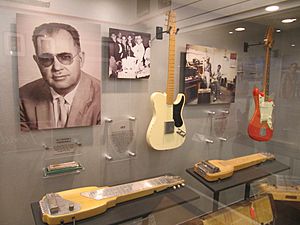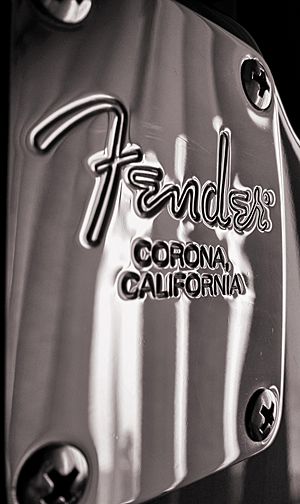Leo Fender facts for kids
Quick facts for kids
Leo Fender
|
|
|---|---|

Leo Fender and his early models "Fender Guitar Factory museum"
|
|
| Born |
Clarence Leonidas Fender
August 10, 1909 |
| Died | March 21, 1991 (aged 81) |
| Occupation | Inventor |
Clarence Leonidas Fender (August 10, 1909 – March 21, 1991) was an American inventor. He is famous for designing many popular electric guitars and basses. He also started the Fender Musical Instruments Corporation.
Leo Fender's designs changed music forever. The Fender Telecaster (1950) was the first electric guitar made for everyone. The Fender Stratocaster (1954) is one of the most famous electric guitars ever. He also created the Fender Precision Bass (1951), which set the standard for electric bass guitars.
Many famous musicians have played instruments designed by Leo Fender. These include Jimi Hendrix, Eric Clapton, David Gilmour, and Stevie Ray Vaughan. Leo Fender was even added to the Rock and Roll Hall of Fame in 1992. Interestingly, he never learned to play the instruments he created!
Contents
Leo Fender's Early Life
Growing Up with Electronics
Clarence Leonidas Fender, known as "Leo," was born on August 10, 1909. His parents owned an orange farm in California, United States. When he was 8, Leo had an eye problem and had to have one eye removed.
From a young age, Leo loved to tinker with electronics. When he was 13, his uncle, who fixed car radios, sent him a box of old radio parts. The next year, Leo visited his uncle's shop. He was amazed by a loud radio his uncle had built. This made a big impression on him. Soon, Leo started fixing radios in a small shop at his parents' home.
In 1928, Leo finished high school. He went to college to study accounting, but he kept learning about electronics on his own. He never took any electronics classes.
After college, Leo worked different jobs, including delivering ice and being an accountant. Around this time, a band leader asked him to build a public address system (PA). This system would help the band's music be heard at dances. Leo built six of these PA systems.
In 1934, Leo married Esther Klosky.
Starting Fender Radio Service
In 1938, Leo and Esther moved back to Fullerton, California. Leo borrowed $600 and opened his own shop called "Fender Radio Service." People came to him to fix their radios.
Soon, musicians also started visiting his shop. They needed help with their sound systems. They also wanted amplifiers for their new electric guitars. These guitars were becoming popular in jazz, big band, and country music.
Building Electric Guitars
First Guitars and Company
During World War II, Leo Fender met Doc Kauffman. Doc was an inventor and played a type of guitar called a lap steel. Doc had worked for Rickenbacker, a company that made lap steel guitars.
Leo convinced Doc to work together. They started a company called "K&F Manufacturing Corporation." Their goal was to design and build amplified lap steel guitars and amplifiers. In 1944, they patented a lap steel guitar with an electric pickup. They started selling a kit with the guitar and an amplifier in 1945. In 1946, Doc left the company. Leo then renamed it "Fender Manufacturing." Later, in 1947, it became "Fender Electric Instrument Co."
The Telecaster: A New Kind of Guitar
After World War II, smaller music groups became popular. They played styles like rhythm and blues and country music. These groups needed louder instruments. Electric guitars were perfect because they could make a few players sound like a whole band.
Older electric guitars were often big and could make unwanted noise (feedback) at loud volumes. Leo Fender saw a need for an electric guitar that was easy to hold, tune, and play. It also needed to be loud without feedback.
In 1948, he finished a new design. It was a thin, solid-body electric guitar. It was first released in 1950 as the Fender Esquire. It had one pickup. The next year, it was renamed the Broadcaster, and then the Fender Telecaster. The Telecaster had two pickups. It quickly became one of the most popular electric guitars ever.
The Iconic Stratocaster
Instead of just updating the Telecaster, Leo Fender decided to create a brand new, more advanced guitar. He listened to what musicians wanted. Guitarist Bill Carson suggested features like adjustable bridge parts and more pickups. He also wanted a special vibrato system and a more comfortable body shape.
Leo Fender, with help from Freddie Tavares, started designing the Fender Stratocaster in late 1953. It had a rounder neck and a special shape with two cutaways. This made it easier to reach the higher notes.
The Stratocaster was special because it had three pickups. These pickups could create different sounds. It also had a "tremolo arm" (which is actually used for vibrato). This arm allowed guitarists to bend notes in a cool way. At first, the guitar had a three-way switch for the pickups. But musicians soon found a way to use the switch to get two pickups working at once. Later, a five-way switch was added to make these sounds easier to get.
Electric Basses: Precision and Jazz
The Precision Bass
Leo Fender also helped bass players. Acoustic double basses were hard to hear over loud bands. They were also big and difficult to carry.
In 1951, Leo released the Fender Precision Bass (or "P-Bass"). This bass was small and easy to move. Its solid body and special pickup allowed it to play loudly without feedback. It was called "Precision" because its fretted neck helped bassists play notes more accurately.
Along with the P-Bass, Fender also introduced the Fender Bassman amplifier. This amp was designed to work perfectly with the new electric bass.
The Precision Bass was updated in 1954 and again in 1957. These updates included a new body shape, a better bridge, and a new pickup design. The 1957 design is still very similar to the Precision Basses made today.
The Jazz Bass
In 1960, Fender released another popular bass guitar, the Fender Jazz Bass. This bass had a slimmer neck and a different body shape. It also had two single-coil pickups, which gave it a different sound than the Precision Bass. The Jazz Bass, or "J-Bass," was an instant success and is still loved by musicians today.
Later Companies: Music Man and G&L
In the 1950s, Leo Fender had health problems. Because of this, he decided to sell his company to CBS in 1965. As part of the deal, he agreed not to start a competing company for a while. After selling, his health improved.
Music Man
In 1971, two friends, Forrest White and Tom Walker, started a company. They asked Leo Fender for help. This company eventually became "Music Man." Leo Fender became its president in 1975.
The Music Man StingRay bass was a very new and exciting instrument. It was one of the first basses made with "active electronics." This meant it had a built-in equalizer to shape its sound. Many famous bass players, like Flea and Louis Johnson, loved the StingRay bass.
G&L Musical Products
In 1979, Leo Fender, along with his old friends George Fullerton and Dale Hyatt, started a new company. They called it G&L (for George & Leo).
G&L guitars looked a lot like Fender's original designs, like the Stratocaster and Telecaster. But G&L also added new features, such as improved tremolo systems and electronics.
Leo Fender continued to design guitars and basses even after having several small strokes. He passed away on March 21, 1991, after a long illness. He was honored with a Technical Grammy Award in 2009 for his amazing contributions to music. A street in Fullerton, California, is named Fender Avenue in his honor.
Images for kids
See also
 In Spanish: Leo Fender para niños
In Spanish: Leo Fender para niños





